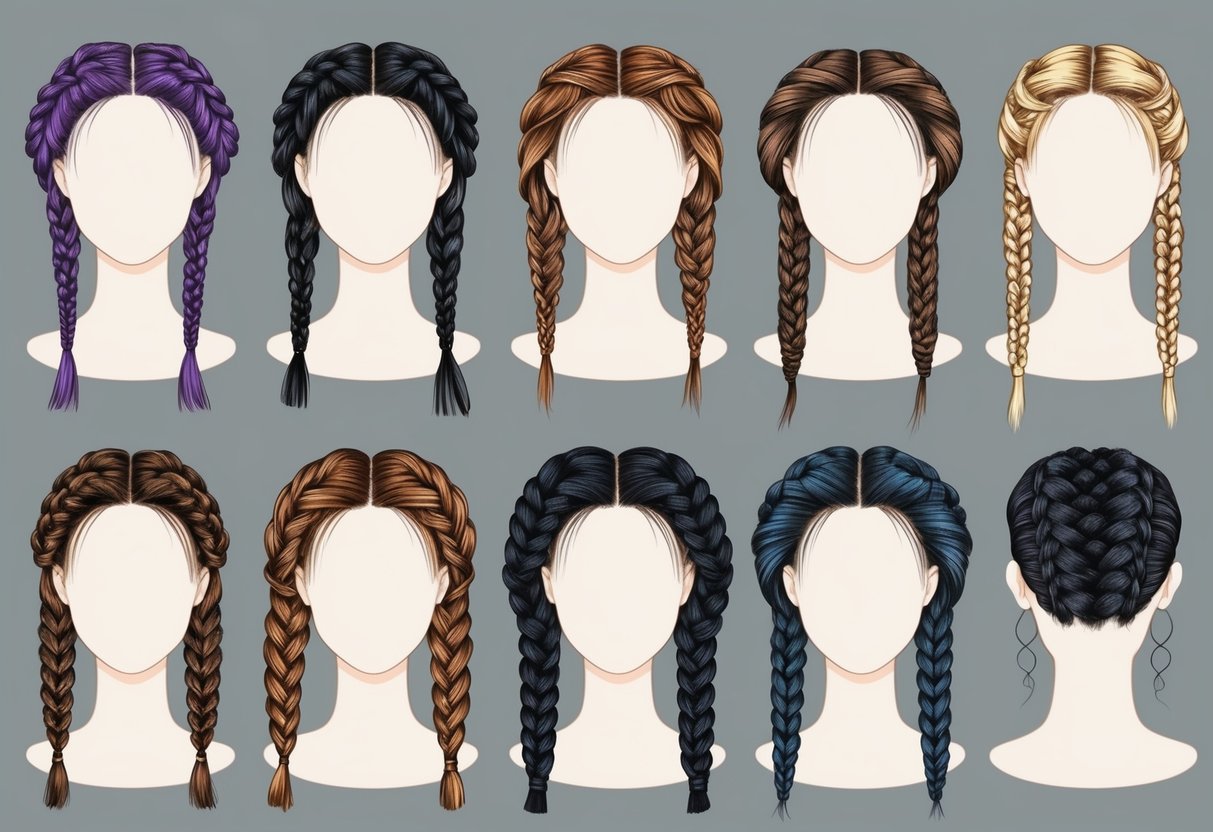
Adapting Feed-In Braids to Hair Texture
Feed-in braids provide a protective hairstyle suitable for diverse hair types. Adapting braiding techniques to different textures enhances comfort, longevity, and the finished look.
Natural Hair Considerations
Feed-in braids work well with natural hair, especially when the hair is properly prepped. Clean, deeply moisturized hair allows for smoother braiding and minimizes breakage.
Using a leave-in conditioner and a lightweight oil helps maintain moisture under the braids. When working with coily or kinky textures, detangling beforehand is essential.
A wide-tooth comb or detangling brush makes this easier. Many stylists suggest stretching the hair with heatless methods, such as braiding or banding, to help reduce tangling while braiding.
Synthetic hair, like kanekalon, is commonly used for creating fuller and longer feed-in braids. It blends well with textured hair, giving a seamless and natural appearance.
Gentle handling throughout the process protects delicate strands and scalp health.
Braiding Fine Hair
Fine hair requires a gentle approach to avoid tension and minimize risk of damage. Lightweight braiding hair extensions reduce strain on the scalp and natural hair roots.
Choosing smaller, thinner sections prevents excessive pulling that can cause breakage or traction alopecia. An important step is to avoid tight braiding, especially at the edges.
Using a nourishing scalp oil or serum adds an extra barrier of protection. A satin scarf or bonnet at night keeps fine hair from drying out and helps preserve style longevity.
Feed-in techniques can actually add fullness and help thin hair appear thicker. For guidance on suitable hair types and extensions, refer to practical resources like the feed-in braid styles guide.
Being strategic about parting and placement results in a natural, voluminous look.
Managing Thick Hair With Feed-In Braids
Thick hair presents unique advantages and challenges when braiding. Its volume supports larger braid styles, but adequate sectioning is important to avoid bulkiness.
Dividing the hair into neat, equal sections before starting helps maintain uniformity. Moisturizing thick hair before braiding prevents dryness and reduces the chance of frizz.
Heavier creams or butters are effective for maintaining hydration under the braids. Opting for larger braids or stitch braiding techniques can make the process more efficient and add texture.
Securely incorporating the synthetic hair ensures the braids stay intact and resist unraveling. Heavier sections may require more braiding hair for a balanced finish.
Proper aftercare, such as regular scalp massages and light oils, supports scalp health and keeps thick hair strong throughout the duration of the style.
Popular Feed-In Braid Styles
Feed-in braid styles offer versatile options for every hair length and texture. Whether someone prefers simple or intricate looks, there are styles that cater to protective needs and unique fashion tastes.
Feed-In Cornrows
Feed-in cornrows use a method where extensions are gradually “fed in” to the natural hair, creating smooth, flat braids that appear seamless and natural. This technique results in a more comfortable and less bulky finish compared to traditional cornrows.
These cornrow styles are popular because they can be customized easily, including straight backs, zigzag patterns, or creative geometric parts. They work well on both short and long hair.
Many opt for feed-in cornrows due to their low maintenance and the way they protect natural hair, promoting growth and minimizing breakage. The final look is neat, making it ideal for casual or professional settings.
Synthetic hair, such as kanekalon, is commonly used to create density and length while maintaining a natural appearance. For more examples and ideas, users can view various feed in braid styles that demonstrate different cornrow looks.
Stitch Braids
Stitch braids are a popular variant of feed-in braids that stand out due to their sharp, defined parts and “stitched” appearance. This effect is created by sectioning the hair into straight lines using styling gel and a rat tail comb, then braiding each segment with added hair in a methodical fashion.
Distinct rows give stitch braids a bold, structured look that sets them apart from standard cornrows. These styles are often worn in straight-back designs but are flexible enough for side parts or intricate, creative patterns.
Stitch braids require precision, so they are best done by experienced braiders. Maintenance involves regular scalp care and gentle handling to keep the defined lines crisp.
The durability of stitch braids makes them appealing for busy lifestyles or special occasions, as they maintain a tidy look for an extended period. Feed-in techniques minimize tension at the roots, providing comfort and reducing the risk of breakage.
Lemonade Braids
Lemonade braids are feed-in cornrow styles worn to one side of the head and gained significant attention after being showcased by Beyoncé. This look features small to medium braids that are intricately curved, creating an elegant and eye-catching pattern.
The side-swept arrangement offers a sleek silhouette while providing full protective coverage to natural hair. Lemonade braids can be customized with accessories, beads, or color for added flair.
This style is particularly versatile—it suits both long and short hair and can be made with a variety of braid sizes. Because of the feed-in approach, the braids lay flatter and look less bulky, delivering a more streamlined appearance than older cornrow techniques.
Lemonade braids can last several weeks with proper scalp care and regular moisturizing. Find more inspiration for lemonade braid looks and learn about their protective benefits.
Fulani Braids
Fulani braids combine feed-in cornrows with unique patterns, often featuring a central braid, side-plaited braids, and decorative elements such as beads and cuffs. Inspired by Fulani tribal traditions, this style emphasizes symmetry and artistic parting.
The feed-in technique allows the braids to blend smoothly with natural hair, providing a sleek foundation for adding adornments. Fulani braids usually incorporate a mixture of thin and thick cornrows, sometimes with a few loose braids hanging in front of the ears for added detail.
Customization is a key aspect; individuals can choose different cornrow layouts and accessorize based on personal taste. Proper care is essential to maintain both the style and the scalp underneath.
View additional Fulani braid variations and styles for more ideas on how this protective look can be personalized.



